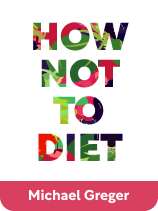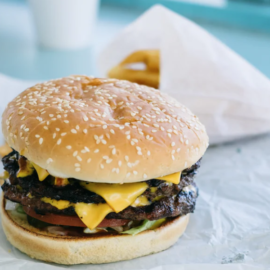

This article is an excerpt from the Shortform book guide to "How Not to Diet" by Michael Greger. Shortform has the world's best summaries and analyses of books you should be reading.
Like this article? Sign up for a free trial here.
What increases appetite? How do processed foods affect your body?
According to Michael Greger in his book How Not to Diet, processed foods and animal products can increase your appetite in four ways. The way your digestive system processes these foods also affects your appetite.
Continue reading to learn what increases your appetite when you’re trying to maintain weight.
Reasons for Increased Appetite
What increases appetite and how? Greger argues that processed foods and animal products increase your appetite in four ways:
1) They quickly leave your stomach: Greger explains that food remains in your stomach until the digestive process, which involves extracting and sorting through any nutrients in the food before excretion, is complete. During this time, your body releases a steady supply of nutrients from the food in your stomach into your bloodstream, creating hormonal changes that make you feel full. However, since processed and animal-derived high-calorie foods are devoid of nutrition and don’t take long to digest, they don’t sit in your stomach for long or provide sufficient nutrients to satiate you.
(Shortform note: Dieticians clarify how quickly processed foods leave your stomach. Nutritionally complex food (such as fiber, protein, and complex carbohydrates) takes your small intestine an average of two hours to process. Since processed foods and animal-derived products aren’t nutritionally complex—because they’re generally composed of simple carbohydrates and fats in their purest form—the small intestine can extract any nutritional content in approximately 30 to 60 minutes. Therefore, as Greger says, these foods don’t keep you full for long.)
2) They trigger blood sugar spikes: According to Greger, the more quickly your body digests food, the more sugar it releases into your bloodstream—creating spikes in your blood sugar levels. This blood sugar spike creates hormonal changes that trigger your appetite. He notes that these blood sugar spikes occur more after eating foods containing high amounts of saturated fats—such as meat and fish—which causes an excessive release of insulin.
(Shortform note: Diabetes research backs up Greger’s claim that quick digestion and saturated fats contribute to blood sugar spikes that increase appetite because they trigger your liver to release more glucose into your bloodstream. However, your diet’s not the only factor that contributes to blood sugar spikes—menstrual cycles, illnesses and injuries, hormonal changes, adrenaline rushes, and anaerobic exercise can also produce the same effect.)
3) They encourage cravings: Greger claims that foods that contain concentrated forms of salt, sugar, fat, and artificial additives initiate the release of hormones that trigger cravings. This means that eating these foods encourages your body to crave even more of them, regardless of how full you are.
(Shortform note: Neurochemical research sheds light on how these ingredients stimulate your hormones to encourage cravings. Foods that contain salt, sugar, and fat are more likely to trigger cravings because, in addition to having an innate tendency to seek high-calorie foods, you also have an innate tendency to seek gratification. The flavors of these ingredients gratify you by stimulating the production of pleasurable neurochemicals in your brain. As Greger says, because food companies are aware of these two tendencies, they intentionally pump high-calorie foods full of salt, sugar, and fat to fuel your cravings and encourage you to consume more.)
4) They don’t nourish you: Greger explains that, because these foods are devoid of nutrition, eating them doesn’t satisfy your nutritional needs. Since your body lacks nutrition, it adopts two defensive measures: First, to prevent starvation, it reduces the number of calories it burns digesting food so that it can store more of these calories as fat reserves. Second, it induces cravings for high-calorie foods in an attempt to satisfy its nutritional needs. This leads you to eat more calories than your body can burn
(Shortform note: Greger implies that eating foods that are calorie-dense and low in nutrition pushes the body to adopt these defensive measures. Dieticians clarify that this isn’t the case: The body only adopts these two defensive measures when it suffers from extreme malnourishment—for instance when someone suffers from an eating disorder and starves their body of nutrition. Starving the body this way decreases muscle mass, which then lowers metabolism. (Recall: the higher your muscle mass, the higher your metabolism.) When your metabolism decreases, you feel more lethargic—leading you to crave foods that will provide a boost of energy.)
An Overview of the Digestive Process
Throughout these four points, Greger argues that the way you digest processed foods and animal-derived products increases your appetite. We’ll clarify his argument with an in-depth explanation of the digestive process.
Nutrients in food provide the cells in your body with the fuel they need to function. Before your cells can access these nutrients, your body must first digest food into molecules that it can absorb into your bloodstream.
1) The digestive process begins in your mouth before you even taste your food. As soon as you think about, see, or smell appetizing food, you start salivating. This saliva contains a digestive enzyme (amylase) that helps break down any starch or sugar in your food.
2) When you chew your food, your saliva moistens it to help you swallow it. The digestive enzymes in your saliva begin breaking down any starch before the food leaves your mouth. This food then moves down into your throat and through a muscular tube (the esophagus). Waves of muscle contractions force the food down through this tube into your stomach.
3) Your stomach muscles then churn and mix the food with digestive juices comprised of acids and enzymes, breaking it into small pieces. This food doesn’t leave your stomach until it’s been processed into a thick liquid (chyme) that’s the right consistency to move into your small intestine.
4) With the help of your liver, gallbladder, and pancreas, your small intestine breaks this chyme down into molecules that it supplies to your bloodstream to feed your cells. This process involves extracting calories and breaking down:
- Protein into amino acids (4 calories per gram)
- Starches into simple sugars (4 calories per gram)
- Fats into fatty acids and glycerol (9 calories per gram)
Once all the food’s nutrients have been absorbed into your bloodstream, undigested matter travels to the large intestine.
5) Your large intestine separates the water from this matter and converts it to solid waste that moves through your colon to your rectum, where it waits until you have a bowel movement.

———End of Preview———
Like what you just read? Read the rest of the world's best book summary and analysis of Michael Greger's "How Not to Diet" at Shortform.
Here's what you'll find in our full How Not to Diet summary:
- How eating processed foods and animal products leads to weight gain
- Why eating plant-based foods reduces the calories your body stores as fat
- What dietary changes will help you shed excess pounds and keep them off






